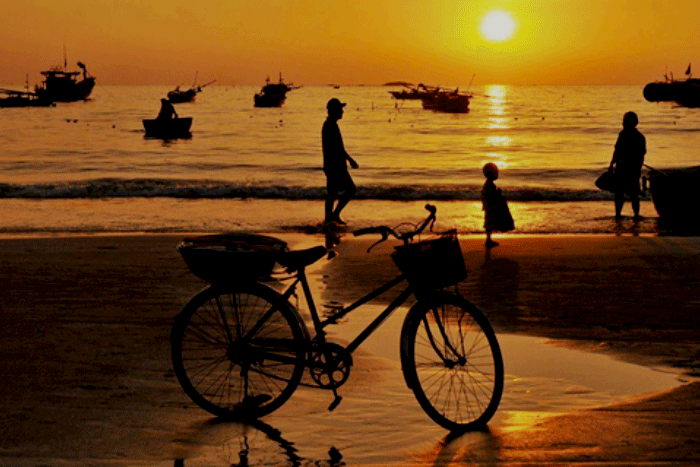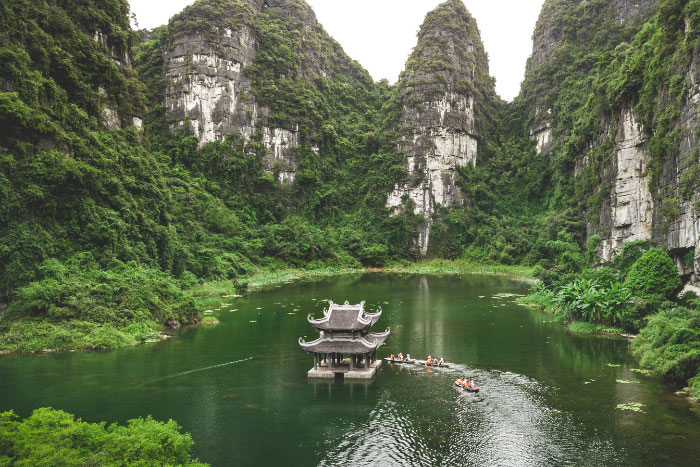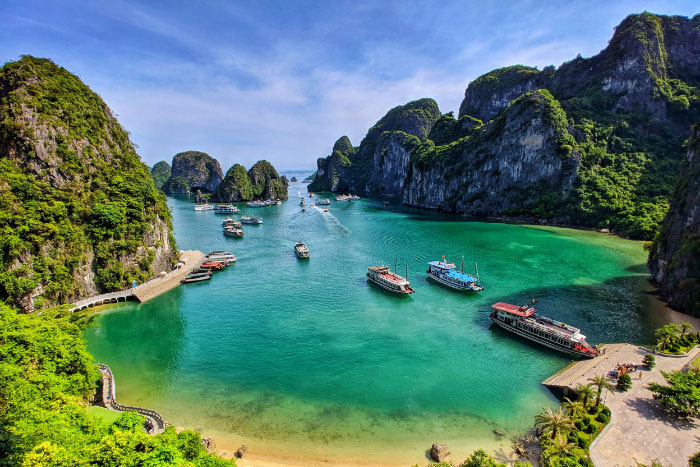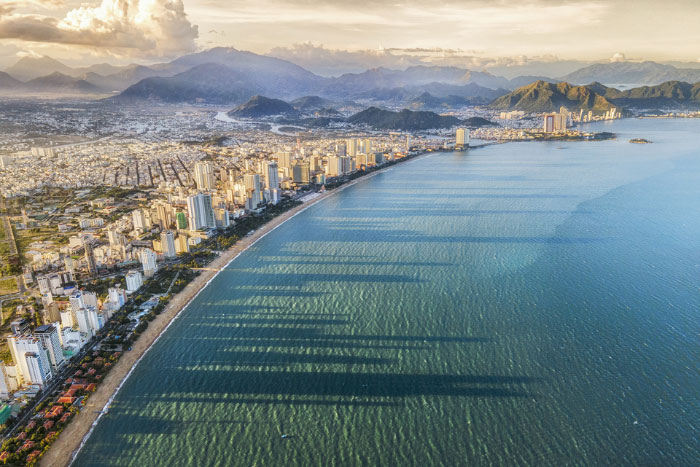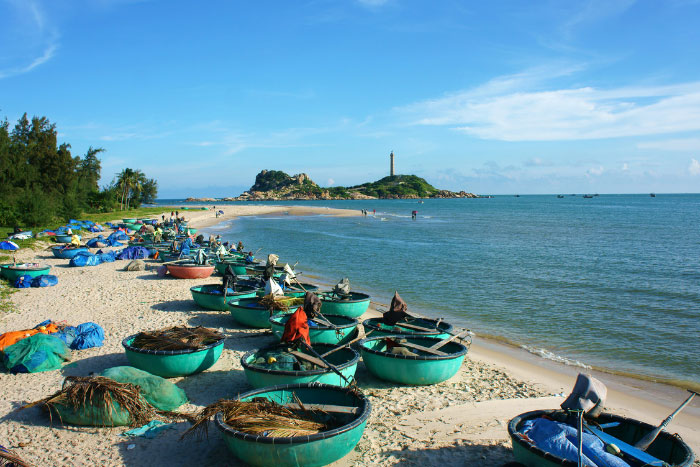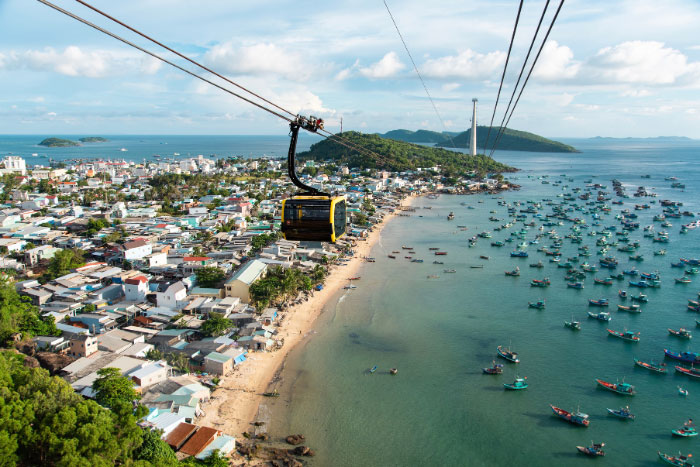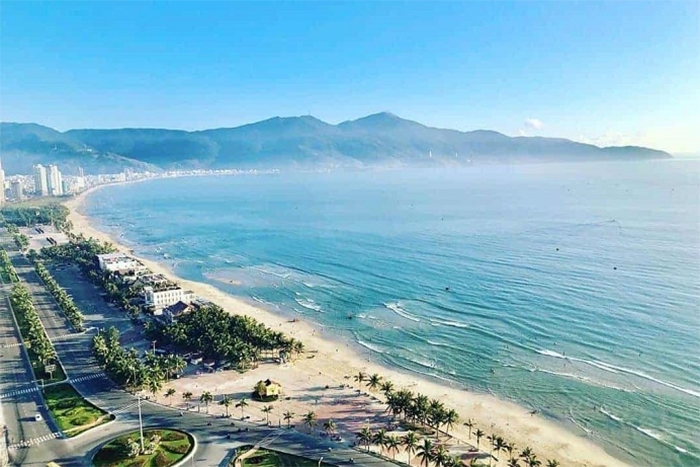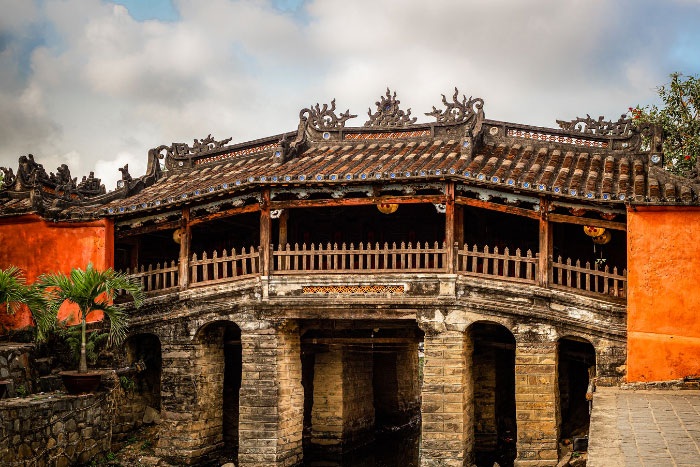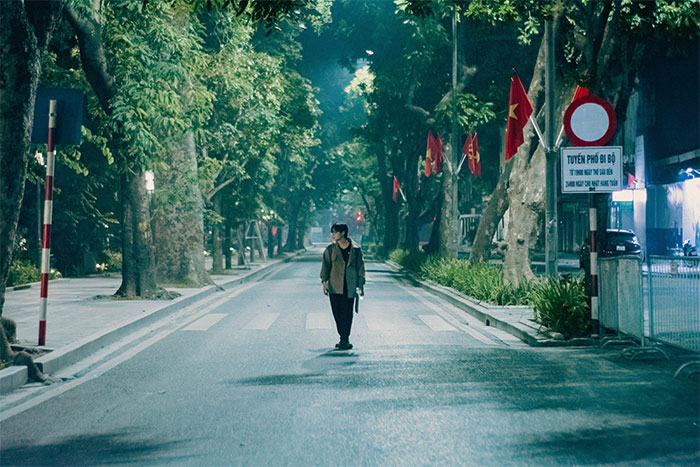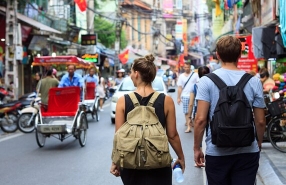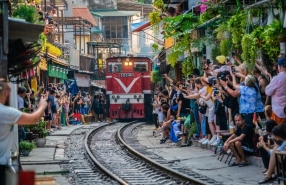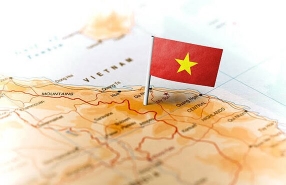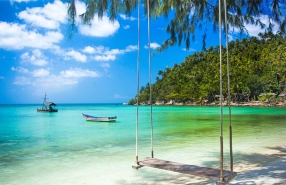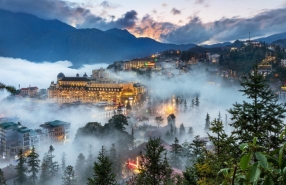
Which Part Of Vietnam Is Most Scenic? Vietnam is a country of stunning natural beauty, with a landscape that ranges from lush green rice terraces in the north to pristine beaches along its extensive coastline. The diverse scenery offers something for every traveler, from towering limestone karsts in Halong Bay to the dense tropical forests of Phong Nha-Ke Bang National Park. So come along to discover the most of Vietnam scenery.
1. Vietnam scenery
Vietnam is a country of captivating natural beauty, where diverse landscapes stretch from the lush rice terraces in the north to the iconic limestone karsts of Ha Long Bay. In regions like Sapa and Ha Giang, rolling mountains, misty valleys, and vibrant green fields create a serene and picturesque environment that enchants visitors.
As you travel south, Vietnam scenery shifts to pristine beaches along the central coast and dense tropical forests in places like Phong Nha-Ke Bang National Park. The vast Mekong Delta, with its intricate network of rivers and floating markets, showcases the rich biodiversity and unique way of life that define southern Vietnam.
2. Where to visit for your prefer scenery
a. The mountains and highlands
Vietnam scenery: So breathtakingly beautiful, where nature and culture intertwine to form a journey. Misty peaks in the north to central rugged highlands—these areas host diverse ethnic minorities, picturesque valleys, and some of Southeast Asia's most beautiful mountain passes. Whether through terraced rice fields, to visits to villages high up, or along winding mountain roads, the mountains of Vietnam form a sensory journey.
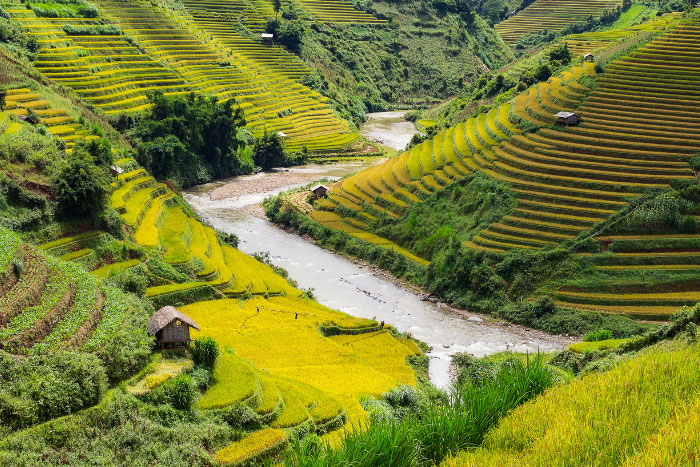
The northern part of Vietnam scenery boasts some of the country's most beautiful mountain scenery, and Sapa's got to be the most famous location. Nestled in the Hoang Lien Son mountain range, Sapa lies within an archetype of a mosaic of green with the terraced rice fields that run down the hillsides to its very rim. The Hmong, Dao, and Tay are some of the ethnic minorities residing here in perfect harmony with the land, and nearly all their traditions are still intact. As such, a Sapa valley trek presents both a challenge and a special opportunity for a visitor to get out and discover vibrant communities and their rich cultural heritage.
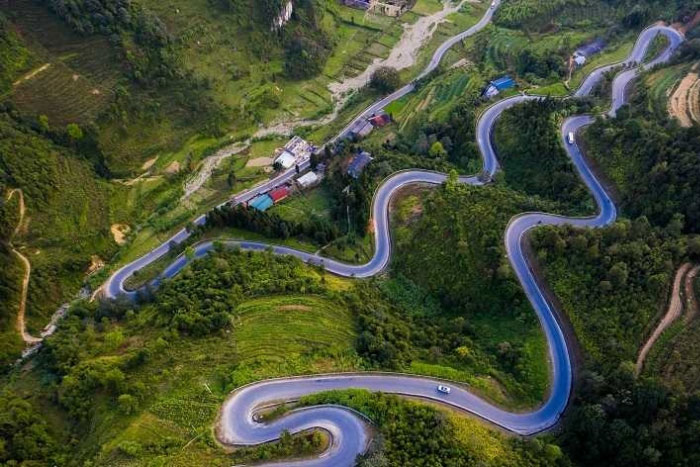
Further north lies the more rugged and remote Ha Giang. The towering mountains of Ha Giang give room to the prominent UNESCO-recognized site, the Dong Van Karst Plateau Geopark, known for dramatic limestone formations. Of all these, however, the Ma Pi Leng Pass stands out. From this vantage point, one can see the Nho Que River as it cuts through deep gorges and jagged cliff faces. It's also home to the Hmong, Tay, and Lo Lo ethnic groups, who retain ancient customs in this untamed landscape.
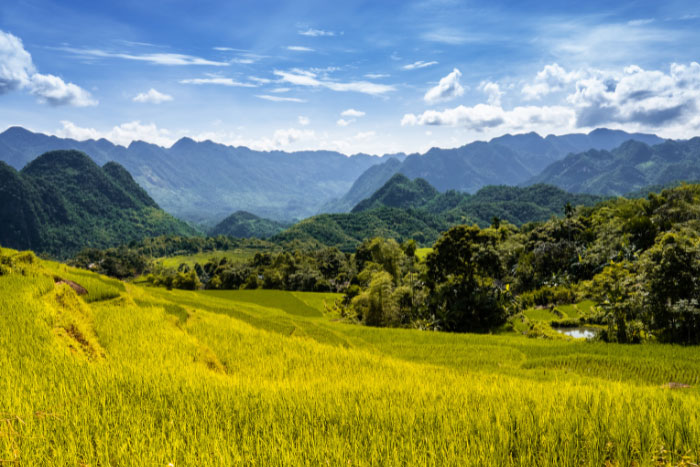
Southwest of Hanoi is the serene escape into nature that is Mai Chau. With its green valleys and rolling hills, Mai Chau is inhabited by the White Thai people, who live in traditional stilt houses. The County is noted for its green rice fields, walking paths, and cultural activities such as homestays and local handicrafts. The neighboring areas of Moc Chau and Son La further unfold the beauty of the highlands, sprawling with their enormous tea fields, flower fields in full bloom, and fresh mountain air, making them excellent spots to relax. Moc Chau has built its tourism brand on an enormous plateau with hills of green tea, plum blossom beauty, and dairy farms. The places were good for nature lovers and photograph enthusiasts. Son La is very rugged, with mountains and deep valleys, and as such, quite influential throughout history and culture. The famous battle that ended French colonial rule in Vietnam was the region's Dien Bien Phu, a place of great historic value and natural beauty with emerald green landscapes and bustling local markets.
Truong Son mountain range dominates much of the Central Highlands of Vietnam, where a different type of adventure waits. Running along the border with Laos, this region is covered with dense forests and full of cascading waterfalls, along with great biodiversity. This is the homeland of Jarai, Ede, and Bahnar ethnic minorities, each of whom has their own traditions and cultural practices. Passing through the Truong Son mountain range, the Ho Chi Minh Highway accounts for a long, winding route to this area of charm in natural beauty and rich cultural heritage.
The province of
Ninh Binh presents a striking combination of mountains and waterways. Ninh Binh is often called "Ha Long Bay on land," with towering limestone karsts rising from emerald-green rice fields and winding rivers. The area is also home to the Trang An Landscape Complex, a
UNESCO Heritage Site where visitors can take boat rides through its cave and waterway system, all set against the dramatic backdrop of mountain scenery.
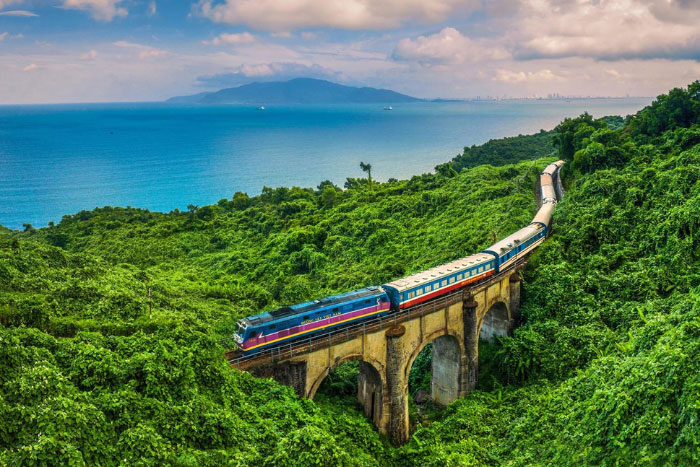
On the coast, one of Vietnam's most famous mountain passes lies between the cities of Da Nang and Hue: the Hai Van Pass. This route has been affectionately nicknamed the "Ocean Cloud Pass," providing great vistas down one side over the sea and lush, forested mountains on the other. Those seeking a more thrilling drive past some of the most breathtaking stretches along Vietnam's coastline need to take the Hai Van Pass. Lying in the far northwest of Vietnam scenery, Dien Bien has more than just inspiring historical landmarks; it is full of beautiful landscapes. The serene lakes and dense forests of Muong Phang National Park will help visitors seek relaxation and solace. Dien Bien is also home to ethnic groups such as the Thai, Hmong, and Kho Mu, who remain faithful to their customs and traditions in this generally isolated region.
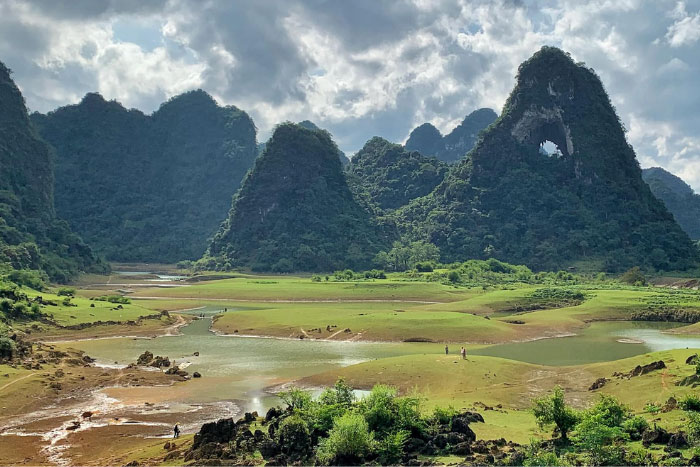
Cao Bang can be found in the northeastern part of Vietnam and is an unsullied beauty, which remains still somewhat offbeat. The fourth-biggest and most beautiful waterfall in the country, Ban Gioc, pours itself down from the mountains, naturally forming a boundary between Vietnam and China. The region also hosts the Nguom Ngao Cave, a lime wonder with stalactites and stalagmites. Cao Bang is a potential destination for off-the-beaten-path adventures, since it is rather an isolated location and its landscapes remain untapped.
Not least of all would be Halong Bay, not because it is mountainous, but because of its iconic limestone karsts dramatically rising from the sea. This UNESCO site is one of the most famous natural wonders of Vietnam, providing opportunities for visitors to take boats and explore among thousands of its islands and islets. The bay comprises peculiar geographical features and enamoring beauty, which no traveling tourist to Vietnam can afford to miss.
The mountains and mountainous areas of Vietnam are real treasures of natural beauties and cultural diversity. From the plunging terraces of Sapa to the rough beauty of Ha Giang, through the sibilant serenity of the valleys of Mai Chau and the historical landscapes of Dien Bien, each village resonates with the rich heritage and stunning scenery of the country. Whether you're trekking far into remote highlands, going on a pulsating journey through ethnic communities, or winding through mountain passes, these mountains bring a promise of an adventure unmatched in this country.
b. The beaches/ocean
Vietnam has more than 3,000 kilometers of coastline with some of the most dramatic and varied ocean scenery in Southeast Asia. From the party-minded beach towns in the south to the serene islands in the north,
Vietnam's beaches and islands are ideal destinations for sun, sand, and sea lovers. Each of its coastal regions is blessed with its particular allure, featuring vibrant and colorful marine life, dramatic limestone formations, and crystal-clear waters that invite travelers to see more.
Vietnam is home to some of the most famous beach destinations, each having that lively atmosphere, soft sandy shores, and warm waters. Nha Trang is considered the "beach capital" of Vietnam, mixing up vibrant nightlife, water sports, and luxury resorts. The long, half-moon Nha Trang Beach is ideal for swimming, sunbathing, or taking a boat trip to some offshore islands, such as Hon Mun, noted for its good diving spots and colorful coral reefs.
Farther south, Phan Thiet and its famous Mui Ne Beach occupy the unique sand dunes and constant winds that make this place a haven for kite surfing and windsurfing enthusiasts. These fishing villages along this stretch of coast also offer a more local experience among which visitors could watch traditional fishing techniques or just sample fresh seafood right on the beach.
Phu Quoc Island, located off the coast of Cambodia, is a tropical paradise rapidly gaining popularity. With its white sandy beaches, limpid turquoise waters, and lush jungles, Phu Quoc is ideal for those in search of relaxation in a more secluded setting. The island also belongs to a UNESCO-designated biosphere reserve, so it is perfect for eco-tourism activities like snorkeling, diving, and hiking in the dense forests of Phu Quoc National Park.
From ancient towns to beautiful beaches, the central coast of Vietnam harmoniously combines cultural heritage and natural beauty. With a long stretch of My Khe Beach, Da Nang is always one of the top spots for relaxation and adventure. The beach itself features on a number of lists of the best beaches in the world, with fine sand, gentle waves, and an impressive backdrop of the Marble Mountains, where one can discover caves, temples, and panoramic views down the coastline.
Just south of Da Nang is the ancient town of Hoi An, which boasts a beautiful coastline. Situated near the heart of town, An Bang Beach is just off the Highway, with its golden sand and transparent waters that afford excellent conditions to enjoy a swim and fresh seafood in one of the local restaurants along the beachfront. So, Hoi An is one such rare destination that blends history with the beauty of the coast, and therefore perfect for those looking for an idyllic blend of culture and relaxation.
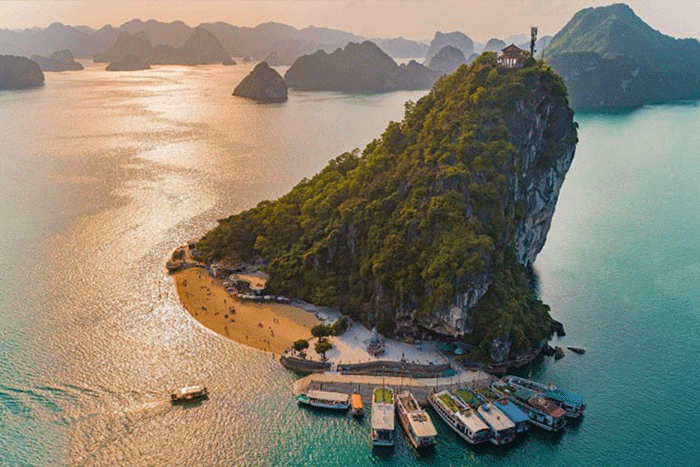
The northern state of Vietnam offers dramatic landscapes with mountains and seas combined. With emerald-green waters and thousands of limestone karsts and islets dramatically rising from the sea, Halong Bay is situated there, world-renowned and a Vietnam UNESCO World Heritage site. Indeed, cruising through Halong Bay is one of the must-try experiences so that one can get into hidden caves, floating fishing villages, or secluded beaches. The bay's unique geography has always made it a favorite with both photographers and nature enthusiasts.

Located off the coast of Halong Bay, Cat Ba is the largest island in the area and provides an excellent base from where to get out and explore. The island is full of rugged cliffs, sandy beaches, and dense forests; much of it is protected as part of Cat Ba National Park. Guests can hike across the park, kayak around outcrops of limestone that jet out of the sea, or simply bask on some of the peaceful beaches that line the coastline. Another hidden gem in the north is Bai Tu Long Bay, which many consider to be the quieter cousin of Halong Bay. Much more peaceful, with fewer visitors yet equally fine landscapes, Bai Tu Long allows travelers to see the beauty of limestone karsts without the crowds. There are some pristine beaches and small fishery villages along this coastline that give an insight into traditional life on the coasts.
From beaches to ocean scenery and islands, all is diverse and beautiful in pretty places in Vietnam. Any traveler—be it to the vibrant southern beach towns, culturally rich central coast, or dramatically landscaped north—should have something that draws them to Vietnam's coastline. From the iconic HaLong Bay to the tropical paradise of Phu Quoc, these beach destinations are sure to offer great times in one
c. The cities
The most beautiful city in Vietnam are one of the most interesting mixes of history, culture, and modernity, with their character and charm. It is in Vietnamese hospitality that noisy metropolises turn into serene towns, providing something for everyone in these urban cityscapes. Every city, from ancient temples to lively markets and from modern glass-fronted skyscrapers, is special for any type of traveler.
Hanoi, the
capital of Vietnam, is a captivating mixture of old and new.
Hanoi's historic Old Quarter has tiny streets and ancient buildings, bringing to life the existence of Vietnamese people. Right in the city center, Hoan Kiem Lake provides a serene atmosphere with lush green vegetation and the legendary Turtle Tower. Grand boulevards and villas—the Hanoi Opera House and St. Joseph's Cathedral were bequeathed by the French.
Hanoi is also a cultural hub with numerous museums, art galleries, and theaters that describe the rich history and vibrant arts of
Vietnam scenery.
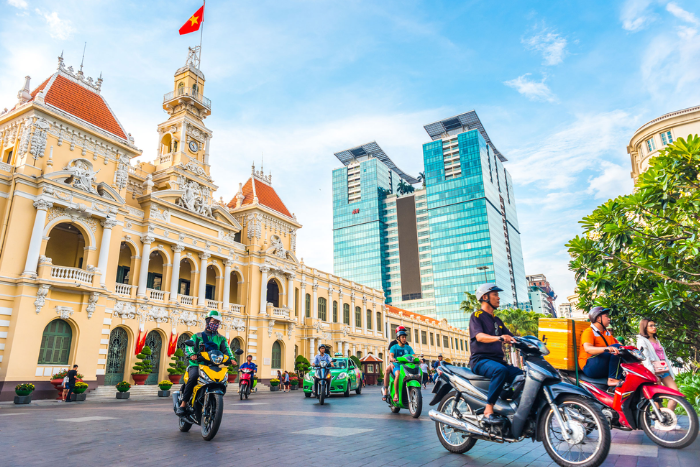
Ho Chi Minh City, formerly known as
Saigon, is Vietnam's largest and most dynamic city. As it is the economic powerhouse of the country, it is a bustling metropolis of modern skyscrapers blended in with colonial-era buildings and traditional temples. District 1 holds the pulse of the city, featuring the stunning Notre-Dame Cathedral Basilica, the Central Post Office, and the historic
Ben Thanh Market. Its lively nightlife, fine dining, and high-end shopping make it compulsory for exploring modern urban Vietnamese life. There's then the relative calm, like the Jade Emperor Pagoda and the expansive Saigon Zoo and Botanical Gardens.
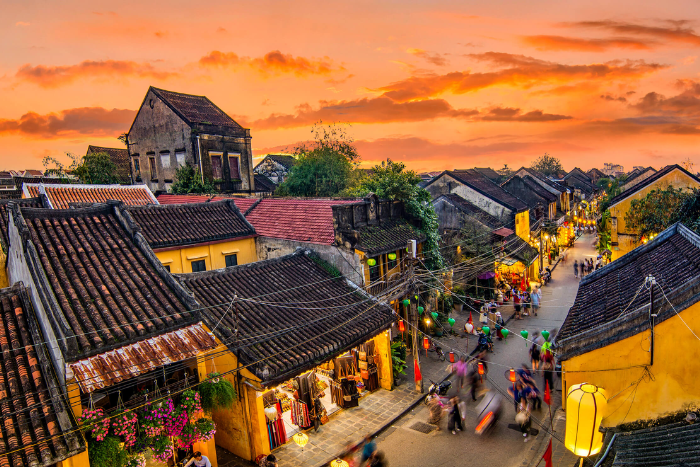
Hoi An is a Vietnam UNESCO World Heritage site known for its ancient town and riverside setting. The historic center is maze-like in streets, lined by traditional wooden houses, vibrant lanterns, and ancient temples. Such is the fusion of Japanese, Chinese, and Vietnamese architecture that imbues Hoi An from its history as a trading port. Its two main claims to fame are thousands of tailor shops, able to whip up custom clothing in no time, and its food scene—cooking classes and street food tours being two of the most popular activities. Not far from the ancient town, An Bang Beach always stands ready to offer a quiet corner, while Thu Bon River offers endless cruising and sightseeing opportunities in the countryside.
Da Nang is a coastal town that has hastened to undergo metamorphosis to become one of the most throbbing urban hubs in the country of Vietnam. Besides its fine coastline with beaches like My Khe and Non Nuoc, Da Nang is also the gateway to many of pretty places in Vietnam: ancient Hoi An Town, imperial Hue City, and other natural wonders. The most beautiful city in Vietnam itself has some fine landmark sites; the iconic Dragon Bridge, breathing fire on weekends, and the Marble Mountains, a cluster of five limestone hills riddled with caves, temples, and panoramic views. The modern landscape of Da Nang is offset by cultural landmarks like the Cham Museum, home to the world's largest collection of Cham artifacts. This makes the city perfect for leisure and exploration, with its relaxed atmosphere accompanied by natural beauty and rich cultural heritage.
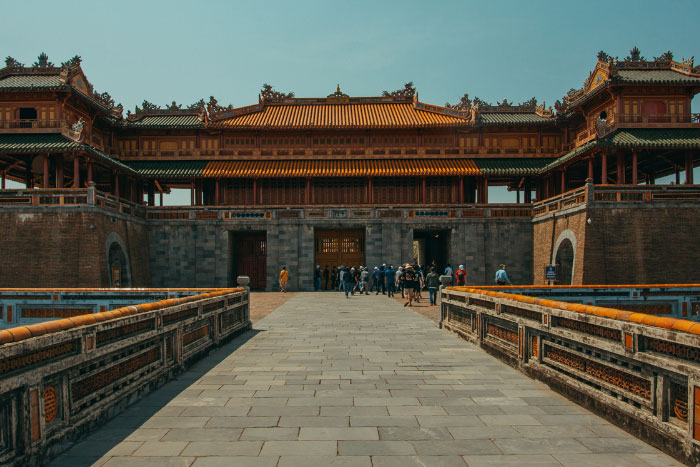
Hue, a city set on the banks of the Perfume River, was bathed in history. It was the old imperial capital of Vietnam, so Hue represents to a greater extent than other imperial cities, with large complexes of palaces, temples, and gardens that formerly served as the seat of the Nguyen Dynasty. Historic significance is imprinted on royal tombs, pagodas, and ancient buildings that dot its landscape—like the celebrated Thien Mu Pagoda and the Tomb Khai Dinh. This serene setting, surrounded by a green environment, makes Hue a perfect location to discover the imperial history of Vietnam. Similar to Ho Chi Minh City, it offers some rare cuisine specialties, such as spicy beef noodle soup, Bun Bo Hue, not to mention other food of this type consumed by emperors before.
The cities of Vietnam each carry a unique view of that country's rich history and culture and its rapid modernization. Whether it is a walk through the ancient streets of Hanoi, soaking up the heady atmosphere in Ho Chi Minh City, or simply lazing around on the beaches of Nha Trang, each city practically beams at the visitor with an experience of diversity and beauty, arguing for the heterogeneity and beauty of Vietnam's urban scenery. The cities would seem indispensable in any traveler's itinerary for a glimpse into the country's past and present.
d. The desert
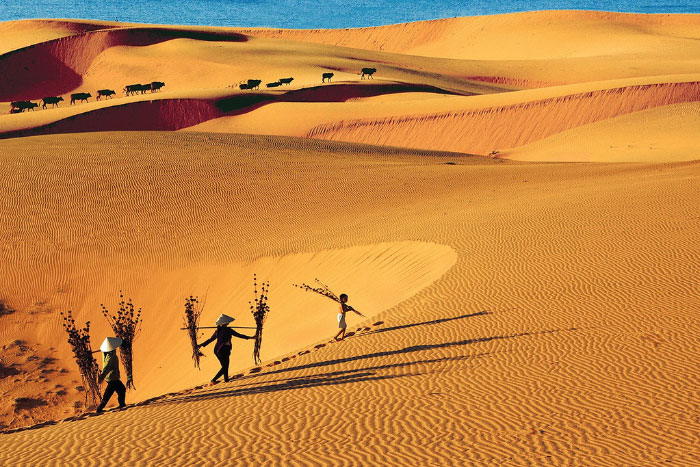
Within the many Vietnam scenery, one will find some quite striking desert-like environments that huge swathes of sand dramatize with contrasts to greenery and coastal scenery usually associated with this country. One of the most famous sand dunes in Vietnam faces a coastal town in the southeastern part of the country called Mui Ne. The largest and most impressive of these White Sand Dunes are located near the locally-named "Bau Trang," which covers more than 50 square kilometers. These dunes are fine, white sand that is popular for activities such as sandboarding and off-road jeep tours. There are small lakes and fishing villages in the surrounding area that add to the picturesque landscape view of the dunes. Not very far from here, the Red Sand Dunes, or "Doi Hong," set quite a contrast viewed against the reddish-brown sand. Though these dunes may be smaller, they are equally magnificent, especially in the morning and evening when the colors of the sand change dramatically due to the light. The Red Sand Dunes are also very fine for trying out sandboarding and camel riding; visitors can go through with fun and adventure.
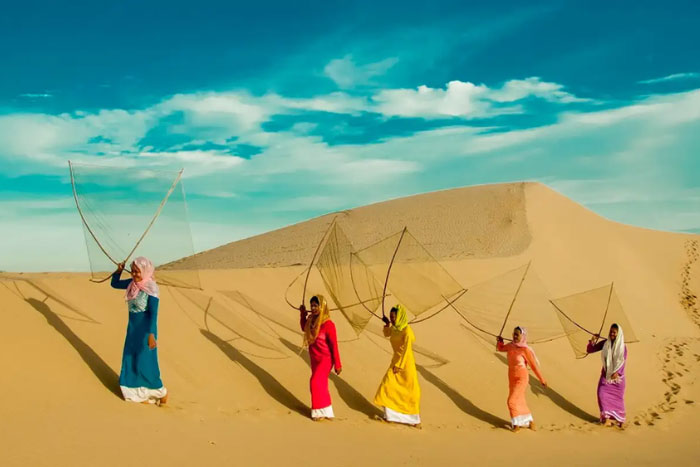
Further north lies another, less famous but very impressive, area of sand dunes—Phan Rang in the Ninh Thuan Province. It has large areas of golden sand and thin vegetation, hence giving it a moon-like landscape. Phan Rang dunes offer a person a much quieter and serene environment to enjoy the scenery of Vietnam's desert landscapes, away from all the noise of the more popular destinations.
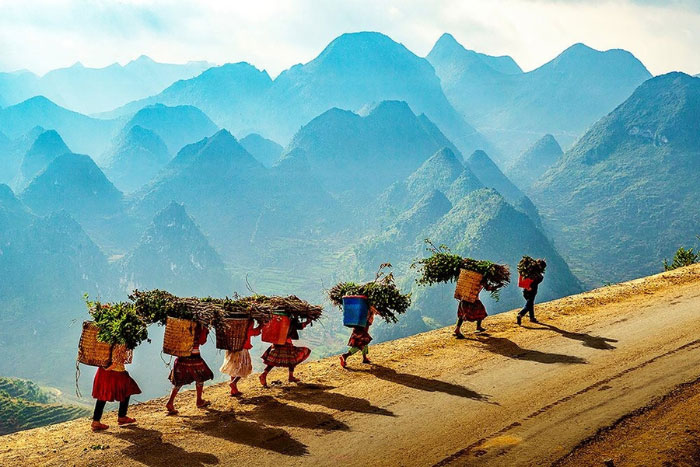
Although this region in northern Vietnam does not have too much of a reputation for its sand dunes, Ha Giang reveals scenes that look like real deserts. Rocky land and karst formations shape dramatic vistas that make them similar to desert environments, yet Ha Giang is part of the mountainous highlands. This stark beauty, so rugged in character, stands in bold contrast with the green scenarios of the rest of Vietnam, offering another kind of natural beauty for travelers who love adventure. Equally unique are the sand dunes and desert landscapes, offering a memorable experience that has put on display diversified natural beauty, giving an adventurous escape from Vietnam's typical tropical scenery.
e. The countryside
The Vietnamese countryside in the north is restful amidst the big cities; it showcases very well the rich agricultural heritage and traditional lifestyles the country is known for. Verdant rice paddies, winding rivers, and villages all help give visitors insight into traditional Vietnamese life.
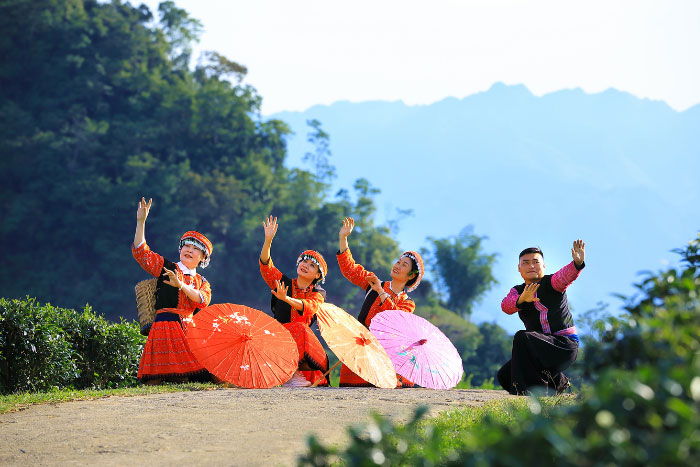
In northern Vietnam, the lush rice terraces of Sapa and Mai Chau create breathtaking landscapes. Sapa, literally lying in the Hoang Lien Son mountain range, is famous for its hill-sliding, sprawling terraced fields that pattern the hillside area in green and gold. Views vary with the seasons: vibrant green in the growing season, golden at harvest time, or with a beautiful winter frost. Mai Chau is a very beautiful valley in Hoa Binh Province thread with traditional Thai stilt-house tradition and covered-by-lg-mounts hills alike, open to idyllic paddy fields. Both give great opportunities for trekking and discovering local ethnic minority culture together with great spots for retreating in peace and quiet or just admiring the views.
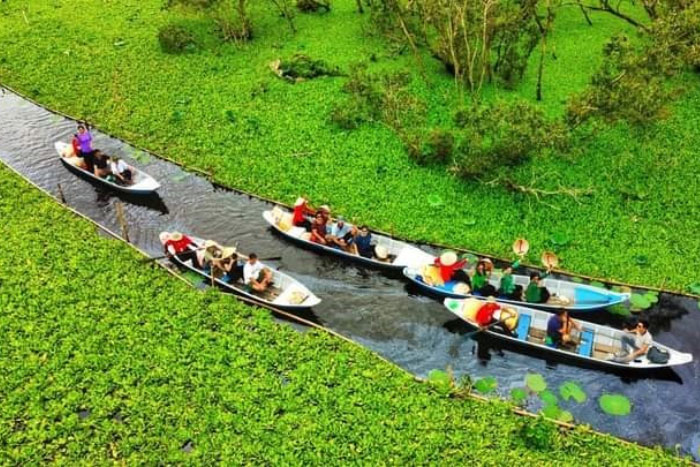
The Mekong is a flat delta in southern Vietnam, formed out of a maze of rivers, canals, and swamps. It is a signboard of plentiful nature. Nicknamed the "Rice Bowl" of Vietnam due to it containing enormous rice paddies, the waterways in this area are filled with floating markets, wooden boats, and houses on stilts. A trip aboard a boat throughout the Mekong Delta becomes an experience in the middle of crowded local markets, where the best of the best of tropical fruits are on offer, as well as bamboo handicrafts workshops. Lush vegetation and winding waterways meet you right at the gateway to this rural idyll.
The central Vietnamese countryside is dotted with rolling hills, fertile plains, and scenic coastal areas. The countryside around Hoi An and Da Nang is a sweet display of rural villages and traditional farming methods, with rice paddies used for rice growing. The countryside surrounding Hue—the ancient imperial capital—boasts historic sites, beautiful gardens, and the romantic riverbank of the Perfume River. This brings together the natural beauty of the countryside with its rich cultural heritage to provide the most fascinating area in which to come and explore.
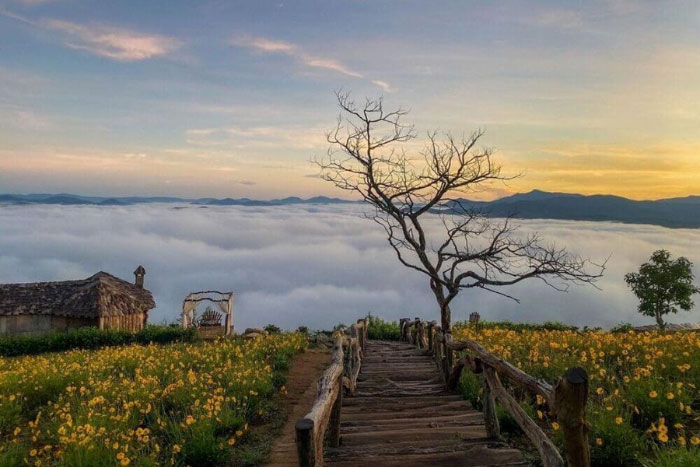
Compared with other places in the Central Highlands, Dalat has a milder climate and more beautiful landscapes. Dubbed the "City of Eternal Spring" because of its temperate climate, it's surrounded by rolling hills, pine forests, and beautiful lakes. Flower gardens, fruit orchards, and charming colonial architecture all add character to this area. It also provides options for visitors to discover a tranquil countryside experience with hiking, visiting local farms, or enjoying peaceful boat rides on lakes. The unique climate and lush surroundings of Dalat are in stark contrast to most of Vietnam, with much of the country being more tropical in nature.
Vietnamese countryside offers a very good sense of being enveloped in the beauty of the country and in its natural environment as well as in its traditional way of life. From the spectacular rice terraces of Sapa and Mai Chau to the dynamic waterways of the Mekong Delta, each area affords a different view of rural pretty places in Vietnam. Of course, the exploration of these areas will lend more insight into the chronological aspect of the country's agricultural heritage and traditional ways of life. The countryside is a must-visit place for those who wish to find peace and have an authentic experience.
3. Some tips for visiting Vietnam
Here are five tips for visiting Vietnam scenery:
Be Prepared for the Climate: Vietnam's weather varies significantly from north to south, so pack accordingly. The north can be chilly in winter, while the south remains warm year-round. The rainy season typically occurs from May to October, especially in the central and southern regions.
Learn Basic Vietnamese Phrases: While many people in tourist areas speak English, learning a few basic Vietnamese phrases can enhance your experience and help you connect with locals. Simple greetings, thank you ("Cảm ơn"), and polite phrases go a long way.
Respect Local Customs: When visiting temples and religious sites, dress modestly by covering your shoulders and knees. Always remove your shoes before entering someone's home or a sacred space, and be mindful of local etiquette, such as avoiding public displays of affection.
Bargain Smartly in Markets: Bargaining is common in Vietnamese markets, but do so respectfully. Start with a counteroffer of about half the initial price and negotiate from there. Keep the exchange friendly, and remember that a smile can go a long way.
Try Street Food, But Be Cautious: Vietnam is famous for its street food, offering delicious and affordable meals. To avoid foodborne illnesses, choose stalls that are busy and have a high turnover of food. Stick to dishes that are cooked fresh, and be cautious with ice and raw vegetables.
Which Part Of Vietnam Is Most Scenic? There you have your answers. By following these instructions, you can easily have the best time of your life here in Vietnam. We hope these informations are helpful for you in preparing for your trip to see
the most beautiful places in Vietnam. If you wish to have a wonderful holiday in Vietnam, don't hesitate to contact
Autour Asia - best travel agency in Vietnam. We invite you to experience the genuine beauty of the Vietnamese people and memorable moment during your travels.
Is Da Nang worth visiting?
Is Da Nang worth visiting? Da Nang is a destination that captivates the hearts of travelers with its captivating blend of charming culture and stunning attractions. Whether strolling along the pristine beaches, exploring historical landmarks like the Marble Mountains and Cham Museum, or immersing oneself in the vibrant local traditions through savoring delectable Vietnamese cuisine and witnessing the intricate craftsmanship of artisans, Da Nang offers a fulfilling travel experience for everyone. From basking in the sun on the soft, golden sands of renowned beaches like My Khe to delving into the city's fascinating past, Da Nang presents a well-rounded destination that caters to diverse interests, making it a destination well worth visiting.
Stephanie Moore
5.0
Excellent
Is North or South Vietnam nicer?
Vietnam scenery is diverse and captivating, with both the north and south offering distinct attractions. The north is renowned for its rugged mountain landscapes, including the iconic Ha Long Bay, while the south boasts pristine beaches and the lush, waterlogged Mekong Delta. Each region has its own unique cultural heritage, vibrant cities, and opportunities for immersive experiences. Whether you're drawn to the north's historical charm or the south's coastal allure, Vietnam's scenery and experiences make it a compelling destination for travelers seeking a rich and varied adventure.
What is the number one tourist spot in Vietnam?
Vietnam scenery is renowned for its stunning natural beauty, and one of the top tourist spots in the country is Ha Long Bay. Located in the northeastern part of Vietnam, Ha Long Bay is a UNESCO World Heritage Site known for its thousands of towering limestone islands and islets, emerald-green waters, and tranquil coves. The bay's unique geological formations, formed over millions of years, have created a truly breathtaking landscape. Visitors can explore the bay by taking boat tours, kayaking through the tranquil waters, or even staying overnight on a traditional Vietnamese junk boat. The area also offers opportunities to visit floating fishing villages, explore caves and grottoes, and hike through lush mangrove forests.

